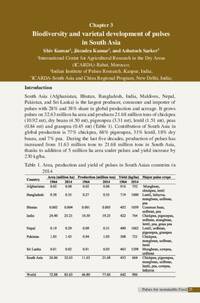Biodiversity and varietal development of pulses in South Asia

Authors:
South Asia (Afghanistan, Bhutan, Bangladesh, India, Maldives, Nepal, Pakistan, and Sri Lanka) is the largest producer, consumer and importer of pulses with 28% and 38% share in global production and acreage. The present productivity of pulses in South Asia is substantially low (664 kg/ha) as compared to global average of 906 kg/ha. To bridge demand-supply gap, South Asia imports about 5 million tons of pulses (Figure 1). In order to augment pulses production in the region, collaborative efforts are thus required for develop- ment of improved varieties of appropriate crop duration having resistance to key diseases prevalent in the region.
Food legumes improvement program at ICARDA is built upon the foundation of its vast germplasm collections and its use to breed new varieties better adapted to different agro-ecological conditions. ICARDA genebank holds 38,000 accessions of chickpea, faba bean, lentil, pea and grass pea. To increase the use of germplasm in breeding programs, the Focused Identification of Germplasm Strategy (FIGS) is recently being pursued at ICARDA with robust geographical datasets. The strategy has proven successful for various adaptive traits such as tolerance to heat, drought, cold, and salt, besides resistance to insect pests and diseases. Such FIGS sets in chickpea, lentil and faba bean are now available to NARS partners to discover and deploy the useful genes into desired agronomic background.
